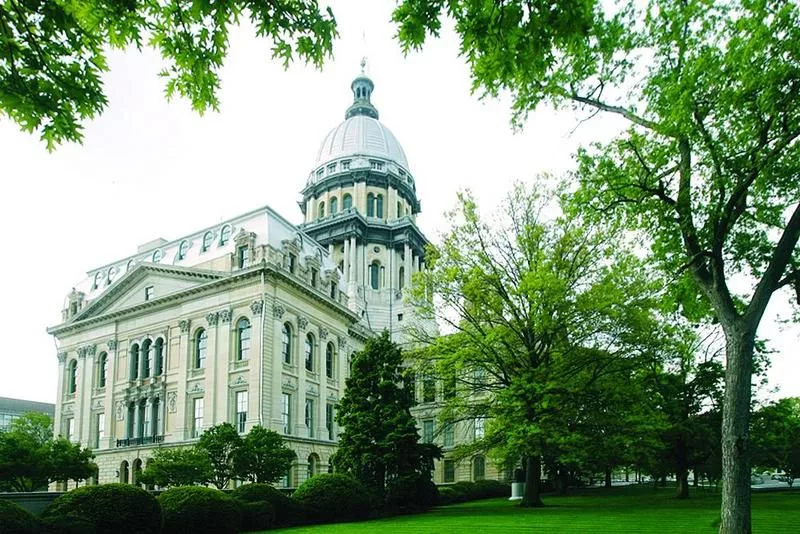
Illinois House and Senate Republicans claimed during budget-related floor debate last week that the super-majority Democrats had masked the true size of their plan by delaying the start of some spending until the second half of the upcoming fiscal year.
Yes and no.
Republicans pointed to the $317 million cost of increasing Medicaid provider reimbursement rates, including for hospitals. But that new spending doesn’t begin until Jan. 1, the halfway point in fiscal 2024, which begins July 1.
And, so, basic arithmetic means the rate increase in fiscal 2025 will be double fiscal 2024′s cost because that 2025 spending will cover all 12 months, instead of just six. That means the state will start the following fiscal year with at least a $317 million hole.
Sometimes, it takes time to stand up new programs, so state spending can’t justifiably begin for a while. That’s the case here as well, according to the governor’s office, which says the higher reimbursement rates can’t start until the state applies for and receives permission from the federal government. And that can take a while.
Also, $317 million is only 0.6% of the $56.6 billion state spending plan. Not much in the grand scheme of things.
While that $317 million is small in context, just think about how much scrambling the Democrats had to do during the past couple of weeks of spring session to collect enough crumbs under the couch cushions to pull its appropriations bill together.

First, they blew well past their self-imposed May 19th adjournment deadline because they couldn’t agree on a spending package. And even then, it took 24 hours after the state’s top Democrats announced a budget agreement that an actual budget bill surfaced because of even more scrambling. And the budget agreement announcement itself was delayed by about an hour because of even more scrambling over relatively small amounts of money.
The Democrats also built only a $100 million cash cushion into this plan, or about 0.2% of total spending. That doesn’t leave them any room if their revenue projections are too low by a tiny fraction, or if spending is higher than anticipated.
Some Republicans pointed to the $550 million in increased spending to cover the exploding healthcare costs for undocumented residents as the reason why Democrats had to get so creative elsewhere. Medicaid providers, they said, could’ve received more money if not for that.
That’s true, but only in the abstract. Yes, proponents (including legislators) and the Pritzker administration vastly underestimated what the healthcare program would cost and how many folks would enroll. And, yes, the governor waited until this spring to turn to the legislature for either statutory relief or the full, guaranteed legal authority via authorized emergency rules to rein in costs in a way that can survive a barrage of lawsuits. Mistakes, as they say, were made.
In the real world, you can’t just wish away problems. “If only,” is a fine game for pundits and politicians. But it doesn’t do you much good when building an actual state budget, which, unlike federal spending plans, can’t rely on simply printing more dollars.
No matter how much some Democrats may have privately grumbled about those massively increased costs, they would not publicly trumpet any sort of solution which kicked thousands of people off healthcare coverage (“Health care is a right” is a longtime Democratic Party talking point, after all) and forced hospitals and other medical providers to go back to treating them without any reimbursements.
And even though there was definitely some resistance and bitterness about those unexpected costs, Black legislators have wisely not had an appetite to publicly inflame the current tensions in Chicago, where some Black leaders and conservative whites are grabbing headlines by echoing angry Fox News talking points about the costs of caring for the influx of mostly Latino asylum seekers.
While some Democrats clung to the notion that Pritzker had the authority to rein in costs without their assistance, they also saw the almost daily and widespread court battles throughout the pandemic over the governor’s use of emergency rules and executive authority.
Determined lawyers on the other side tied the attorney general’s office up in knots throughout the pandemic and have so far succeeded at stymying the implementation of both the SAFE-T Act and the assault weapons ban.
Lawsuits over limiting enrollment, and putting undocumented immigrants into managed care programs might still be filed, but the state will be on much firmer legal ground by specifically allowing the governor to file emergency rules.
• Rich Miller also publishes Capitol Fax, a daily political newsletter, and CapitolFax.com.












